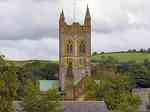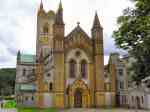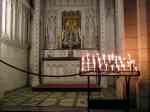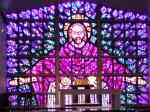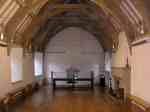| Founded in 1018 by an order of Benedictine monks, Buckfast
abbey was transferred to the Cistercian order during the mid 12th century
and rebuilt in stone. The Cistercian monks, renowned for sheep farming in
medieval England, developed the Abbey into becoming a major wool exporter
by the beginning of the 14th century. In 1539, the Abbey was abandoned due
to the Dissolution of the Monasteries by Henry VIII. The Abbey and Estate
passed through various owners until it became the property of Dr. James
Gale in 1872. In 1882 Dr. Gale decided to sell the property, but was keen
to offer it to a religious community and advertised it as "a grand
acquisition could it be restored to its original purpose." The Abbey,
originally leased from Dr. Gale but purchased the following year, became
the home to a small community of Benedictine monks, exiled from their own
monastery in France who had made their way to England. They carried out
excavations of the site to reveal the original ground plan of the medieval
Cistercian abbey. Mr. Frederick Walters, a leading architect of his day
drew up plans for the restoration of the abbey based upon these foundations
and comparisons with other Cistercian Abbeys. In the meantime, the monks
improved the little that remained of the existing monastery buildings restoring
The Abbot's Tower and erecting a temporary church (now the Chapter House).
Buckfast was reinstated as an abbey in 1902 and Boniface Natter was blessed
as Abbot on 24th February, 1903. Rebuilding of the original Abbey church
began in 1907 under Abbot Vonier who had succeeded Abbot Natter after his
tragic death in a shipwreck in 1906. The Abbey church took 32 years to complete,
built entirely by the monks themselves working normally in a team of four
with the final stone being laid on the tower on 24th July, 1937.
Today the monks welcome visits to their Abbey Church and the Abbey is
financially self-supporting with its restaurant, tea rooms and gift shops
selling produce from the Abbey estate. The monks, like their medieval
predecessors, following their regime of prayer of worship but also being
potters, brewers, winemakers, fruit growers and beekeepers. Their most
famous product, sold all over the world, is Buckfast Tonic Wine, however
the Abbey is also famous for its honey and its disease resistant Buckfast
bee. This strain of bee was bred by Brother Adam of Buckfast Abbey in
the early 20th century after many hives throughout the country were decimated
by a disease called called acarine. Colonies of the Buckfast bee have
now been established all around the world from surplus queen bees sold
by the monks. |
